Experiential Learning: Why We Simulated a Hurricane Strike
As weather information (and misinformation) becomes ubiquitous on social media, national meteorological services must provide clear guidance about the hazards associated with tropical cyclones to local leaders, emergency managers, the media, and the public. To meet this need, COMET worked with the World Meteorological Organization (WMO) and National Hurricane Center (NHC) to provide cutting-edge training to meteorologists across the Atlantic.
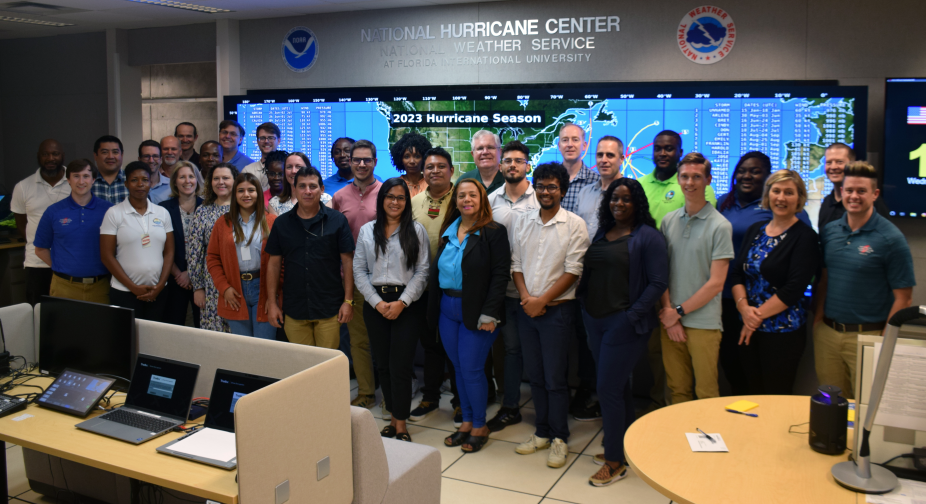
The learners and instructors for the 2024 NHC – WMO Tropical Cyclone Forecasting course.
The NHC - WMO Tropical Cyclone Forecasting Course
To prepare for hurricane season (June 1 – November 30), the U.S. National Weather Service (NWS) National Hurricane Center (NHC)—through funding from the World Meteorological Organization (WMO)—brings together meteorologists from across the Atlantic to Miami, Florida, for their annual tropical cyclone forecasting training.
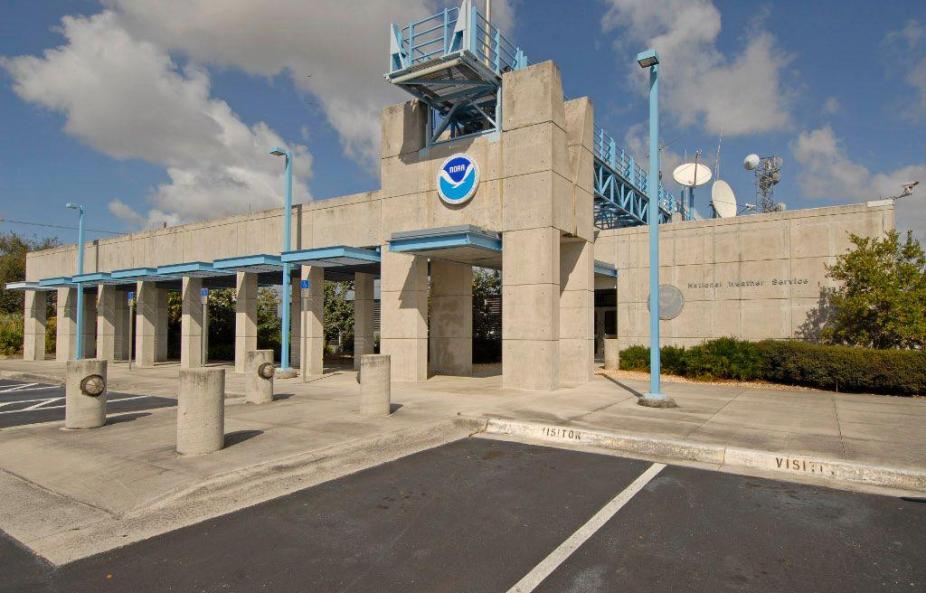
The NWS National Hurricane Center in Miami, Florida.
This intensive workshop trains meteorologists on the latest and most effective tropical cyclone forecasting approaches so they can provide their communities with the severe weather support they need. Historically, the NHC developed and facilitated the course. This year, however, they decided to team up with professional education and training design experts.
And that's where the COMET Program comes in.
A Weather-Ready Partnership
This vital course helps meteorologists save lives. Participants learn how to provide effective impact-based forecasting and decision support to help leaders make informed decisions when disaster strikes. To maximize course engagement and comprehension, Jamie Rhome—Acting Director and Deputy Director of the National Hurricane Center—reached out to COMET to help revamp the course. COMET’s participation is funded by the USAID Bureau of Humanitarian Affairs (BHA) and the NOAA National Weather Service International Activities Office.
In an anonymous post-course survey, participants supported the partnership between the NHC and COMET:
“I think that the course was fantastic, I learned more than I thought I would, especially in such a short period of time. The fact that this was a complete revamp from prior years was extremely impressive, you would not be able to tell this was the first time the course was run this way.”
“Thank you so much. Overall, one of the best training programs I have taken part in. The week flew by which to me is a sign that it was successful.”
Here’s what we did to help revamp the course and energize learners.
Training the Trainers
COMET members Tsvet Ross-Lazarov (COMET Instructional Designer), Kathryn Payne (COMET Innovative Capacity Program Project Manager), and James Russell (COMET Scientist) teamed up with NHC subject matter experts to make the course more interactive for participants.
To start, the COMET team trained the trainers—the NHC instructors leading the course. They worked with the instructors to craft interactive sessions on various tropical cyclone forecasting topics based on evidence-backed strategies for engaging learners.
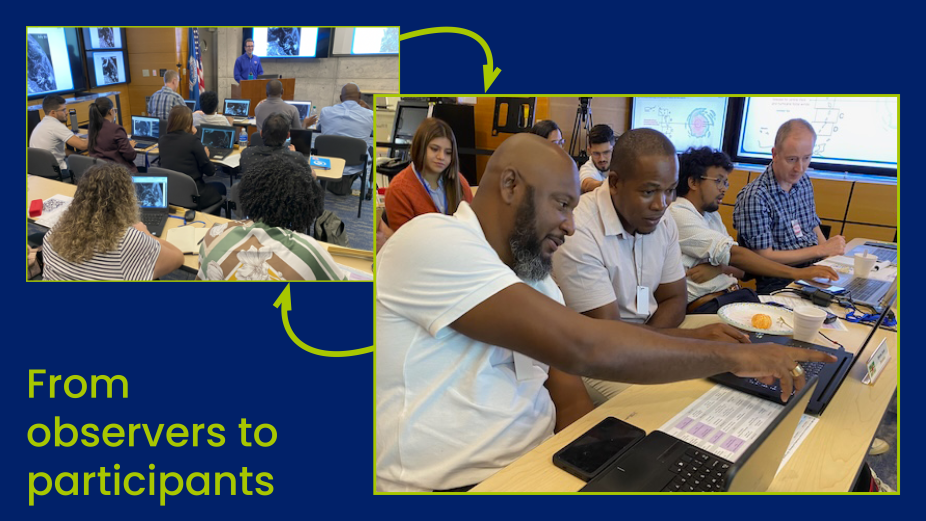
COMET worked with the NHC instructors to develop sessions that drove interaction and engagement.
For example, the team guided the instructors on best practices for embedding games, exercises, peer instruction, and poll questions in their presentations. These elements engaged learners in the presentations while also providing the NHC instructors with real-time and post-training data they could use to better understand the training needs of their audience.
Learner Immersion: Hurricane Barney
On day four of the course, a hurricane hit. More accurately, a simulated Hurricane Barney (modeled after Hurricane Elsa from 2021) was projected to make landfall, and participants needed to make their affected communities severe weather-ready.
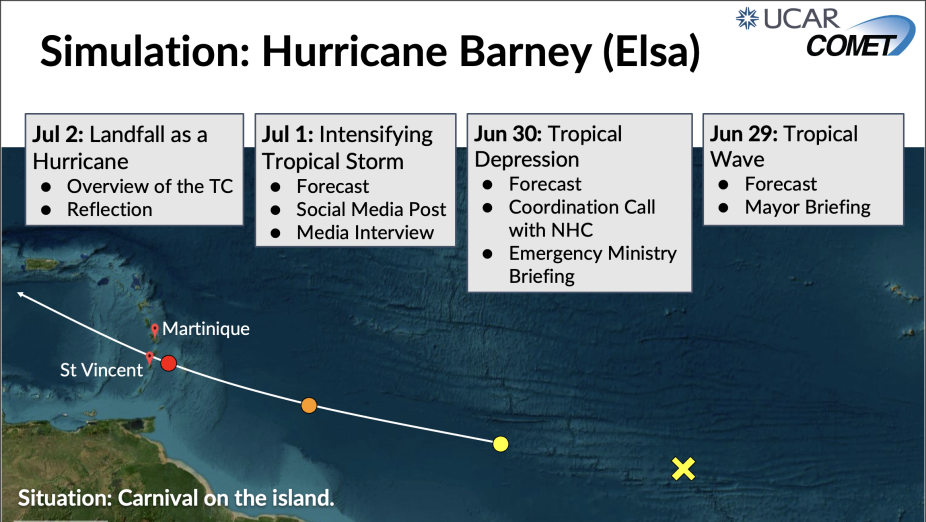
The simulation was arranged around Hurricane Elsa’s track (renamed Hurricane Barney for the purposes of the course).
Participants donned their forecaster hats while NHC and COMET staff became Emergency Ministers, media representatives, and city mayors. To fully immerse participants, the COMET team coached the NHC roleplayers on how to react in different scenarios. For example, when a participant went over the three minutes allotted to brief a busy mayor, the “mayor” stormed out of the meeting. The “media” also asked pointed questions about how climate change was affecting the storm.
The COMET team also provided the learners and instructors with learning materials, including interview planning worksheets, scripts, and rubrics. These materials were available in both Spanish and English to provide all learners with an equitable learning experience.
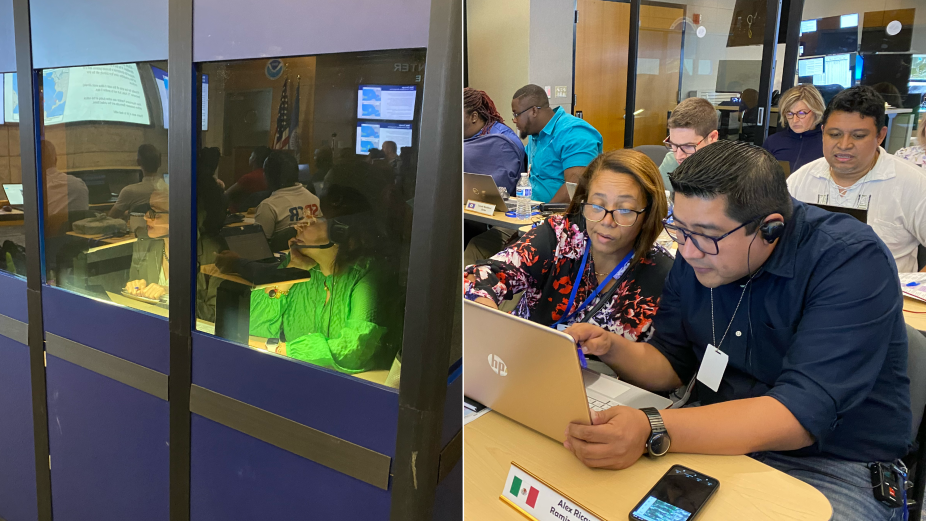
Translators provided real-time, seamless learner-language integrations.
Simulating Three Days of Severe-Weather Forecasting
The simulation took participants through three forecast timesteps spread across the three days leading up to landfall. At timestep one, participants created presentations to communicate their forecasts. They then briefed an NHC member who acted as the mayor of their island.
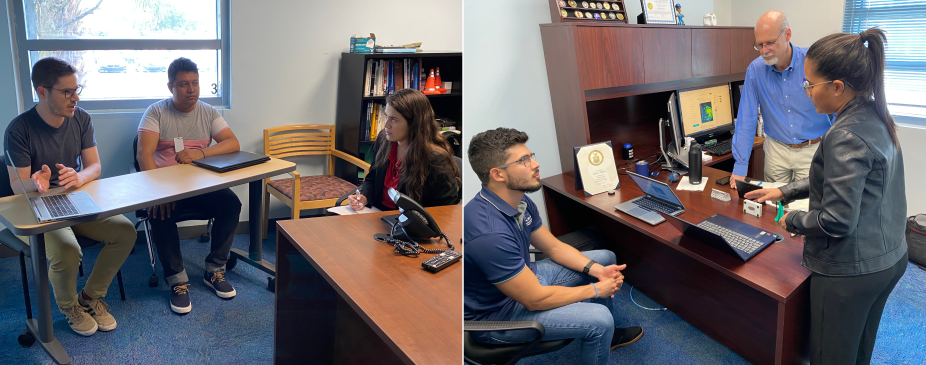
Participants brief an island “mayor” on their forecasts for the incoming hurricane.
Participants updated their forecasts at timestep two, then attended a mock coordination conference call with NHC staff to make a joint decision on issuing Tropical Storm or Hurricane watches/warnings. They finished the “day” with a briefing to Emergency Ministers.

Participants created forecasts, attended a mock NHC conference, and gave mock media interviews during the simulation.
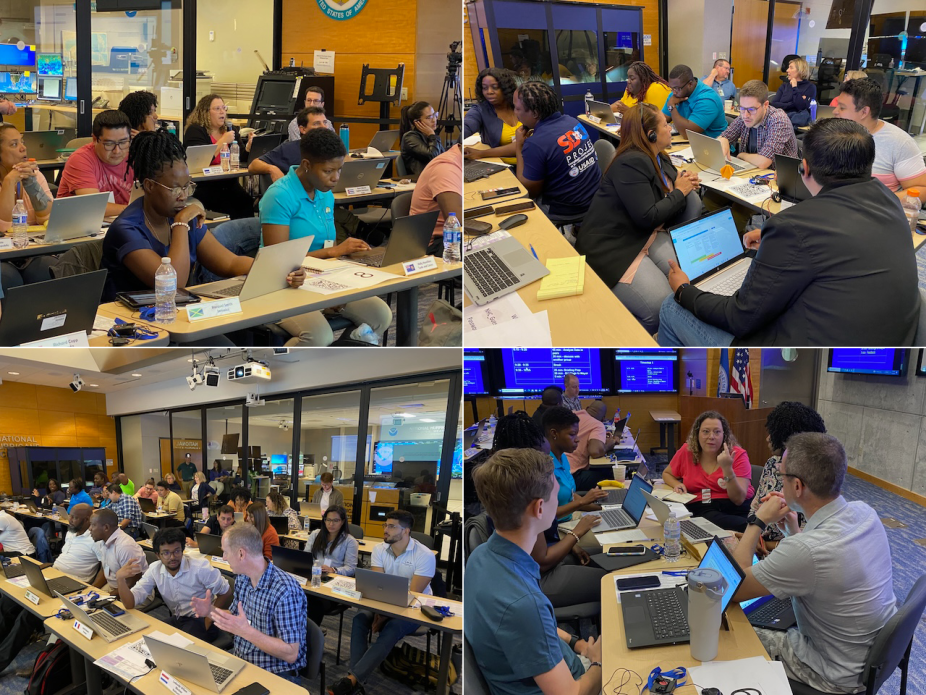
Participants work on their forecasts.
Timestep three tested participants’ ability to communicate with the general public as the hurricane posed an immediate threat to their island. They created a social media post, and then updated the public via news interviews.
“Simulations are very effective learning experiences,” said COMET Instructional Designer, Tsvet Ross-Lazarov. “They place the learners in realistic situations and ask them to solve problems and practice different skills in various situations. If we look at current learning science research, simulations also engage ‘the same mental processes that will be needed later in applying the learning in everyday settings. By mimicking the challenges of practical experience, these learning strategies conform to the admonition to “practice like you play, and you’ll play like you practice,” improving what scientists call transfer of learning, which is the ability to apply what you’ve learned in new settings (Brown et al).’”
“Simulations are very effective learning experiences.”
— COMET Instructional Designer, Tsvet Ross-Lazarov
Reflections and Discussion
Hurricane “Barney’s” landfall set the stage for the final day of the course—Reflection. An NHC forecaster provided an overview of the event and its real-world forecast challenges, inviting participants to start reflecting on their forecasts.
These reflections continued as COMET and NHC staff provided individual feedback on participants’ social media posts and recorded media interviews. Participants also viewed and self-critiqued their own performance on the media interviews. Finally, everyone came together for facilitated discussion (and more reflection) on ways they could improve their forecasting and communication approaches.
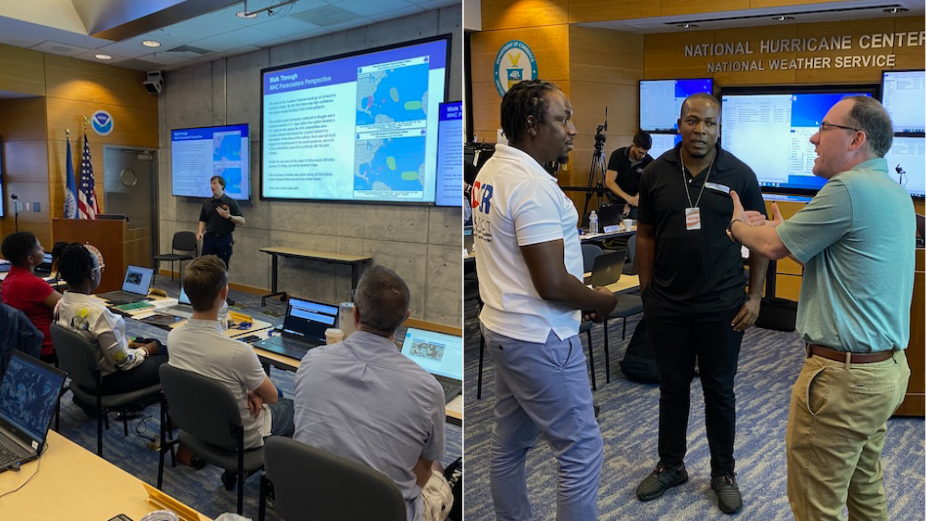
After an overview of Hurricane Elsa and its real-world forecast challenges by the NHC (left), learners engaged in deeper reflections, discussions, and feedback sessions (right).
How Did It Go?
So, did these new training strategies work? Survey (specifically, course feedback, reviews, and focus group interviews) says: Yes! COMET is committed to providing scientifically backed, innovative learning experiences, so we followed our own advice and included numerous opportunities for learners to provide feedback throughout the course.
What did the learners think about the course? Every participant rated the simulation as “Very Useful.” The course participants ranged from those new to forecasting (about 50%) to seasoned forecasters with 10+ years of experience (18%), and all participants—regardless of experience—rated the course highly.
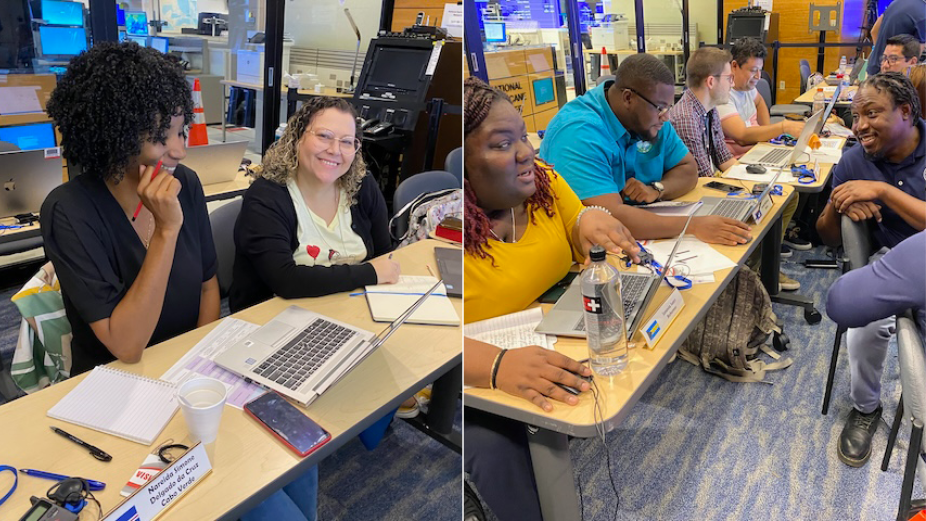
Participants enjoyed collaborating during the interactive exercises.
Learners also valued the interactions embedded in the NHC presentations, reporting that the polls helped them engage in discussion, think critically and apply ideas, and make decisions.
For example, 95% of respondents indicated that the poll questions and discussion “helped me think critically about and apply the ideas presented in the course.”
The polls also helped learners discuss with each other how to use the ideas, and 73% indicated that poll questions “asked them to make decisions like those they will face on the job.” So in addition to learning new ideas, poll questions gave learners an immediate opportunity to apply what they have learned.
Here’s what a few of the participants had to say about the interactions and simulation in our anonymous post-course survey:
“Was very effective having to do the simulation which challenged my analysis skills, decision-making skills, and communication skills when under pressure and deadlines.”
“The communication exercises, while tiring and stressful, really provided a great simulation of a busy day on the desk and helped apply all that was learned through the week. The poll questions and discussions were great at keeping me engaged.”
“I feel better equipped to deal with public and media personnel. I have more confidence in my ability to issue forecasts. I will be able to better communicate risk and impacts and will include some level of uncertainty when doing my forecast. [I] will no longer just rely on one model.”
Choosing only a few comments from the overwhelmingly positive feedback was challenging but inspiring. Hearing how the simulation resonated with learners is a huge motivation for our team to continue incorporating more simulations into our education and training resources to meet and exceed our partners’ needs and expectations.
Learn More About COMET
We have built weather, water, and climate expertise worldwide since 1989. Learn more about who we are, our work, and more here.
Check out our catalog of more than 1,000 free weather, water, and climate education & training resources on COMET MetEd.
Subscribe to our newsletter and follow us on social media to keep up with the latest COMET news, lessons, job opportunities, events, and more!
Sources Cited
Brown, Peter C.; Roediger III, Henry L.; McDaniel, Mark A. (2014). Make It Stick: The Science of Successful Learning (pp. 85-86). Harvard University Press. Kindle Edition.